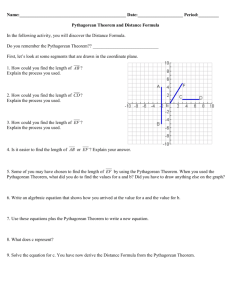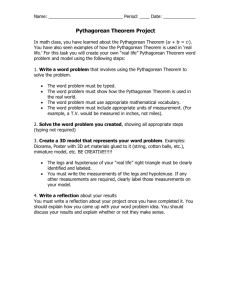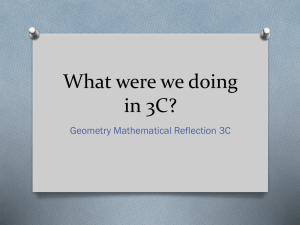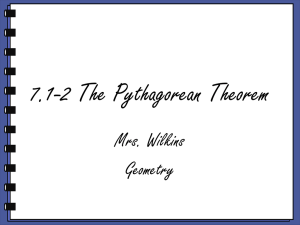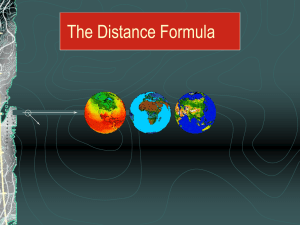Section 2
advertisement
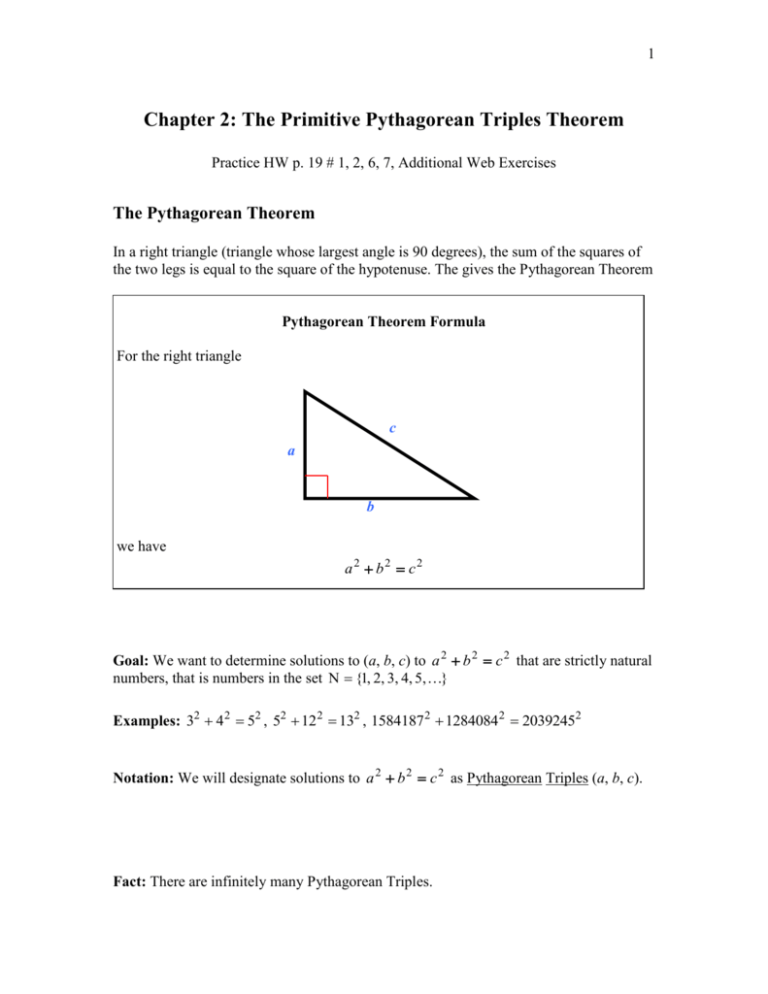
1
Chapter 2: The Primitive Pythagorean Triples Theorem
Practice HW p. 19 # 1, 2, 6, 7, Additional Web Exercises
The Pythagorean Theorem
In a right triangle (triangle whose largest angle is 90 degrees), the sum of the squares of
the two legs is equal to the square of the hypotenuse. The gives the Pythagorean Theorem
Pythagorean Theorem Formula
For the right triangle
c
a
b
we have
a2 b2 c2
Goal: We want to determine solutions to (a, b, c) to a 2 b 2 c 2 that are strictly natural
numbers, that is numbers in the set {1, 2, 3, 4, 5, }
Examples: 32 4 2 52 , 52 122 132 , 1584187 2 1284084 2 20392452
Notation: We will designate solutions to a 2 b 2 c 2 as Pythagorean Triples (a, b, c).
Fact: There are infinitely many Pythagorean Triples.
2
Why? If (a, b, c) is a Pythagorean Triple, then (da, db, dc) is a Pythagorean Triple since
a 2 b2 c 2
(since (a, b, c) is a Pythagorean Triple)
d 2 a 2 d 2b2 d 2 c 2
(multiply both sides by d 2 )
(da) 2 (db) 2 (dc) 2
(rewrite, hence revealing (da, db, dc) is a Pythagorean Triple)
However, da, db, and dc all have a common factor (divisor) given by d. We want to find
Pythagorean triples with no common divisors.
Definition: A Primitive Pythagorean Triple (PPT) is a Pythagorean triple (a, b, c)
where a, b, and c have no common factors (divisors).
Examples of Primitive Pythagorean Triples: (3, 4, 5), (5, 12, 13), (15, 8, 17),
(1023, 64, 1025), (1584187, 1284084, 2039245).
Definition: An integer d is said to divide an integer m, written as d | m , if m kd for
some integer k. The integer d is said to be a divisor or factor of the integer m.
Examples:
Facts Concerning Divisibility
1. If d | m and d | n , then d | m n and d | m n .
Proof:
2. If d | km and d | kn and m and n have no common divisors, then d | k .
Proof: Chapter 7
3
Claim: For a Primitive Pythagorean Triple (a, b, c), either a or b is odd (but not both)
and c must be odd.
Proof of Claim:
█
4
For Primitive Pythagorean Triples (a, b, c), from now on we will assume that a is odd, b
is even, and c is odd.
To generate Primitive Pythagorean Triples, we use the following theorem.
Theorem: Primitive Pythagorean Triples Theorem: Every Primitive Pythagorean Triple
(a, b, c) with a odd, b even, and c odd, can be generated using the formulas
a st ,
b
s2 t 2
,
2
c
s2 t 2
2
where s and t are odd positive integers with s t 1 that are chosen with no common
divisors.
Proof: Since (a, b, c) is a Pythagorean Triple, a 2 b 2 c 2 . Hence,
a 2 c 2 b2 (c b)( c b) .
We first claim that ( c b) and ( c b) have no common divisors larger than 1. Suppose
this is not true, that is, suppose there is a positive integer d 1 where d | ( c b) and
d | ( c b) . Since (c b)( c b) a 2 , it follows that
d | a2 .
Now, since d | ( c b) and d | ( c b) , it follows that
d | [( c b) ( c b)] or d | 2c
and
d | [( c b) ( c b)] or d | 2b
Since b and c have no common factors (because they are produced from a Primitive
Pythagorean Triple), it follows from Fact 2 above that d | 2 . Hence d 1 or d 2 .
However, d | a 2 where a 2 is odd. This implies d 1 . Thus ( c b) and ( c b) have no
common divisors larger than 1.
Now, a 2 (c b)( c b) is a perfect square, which can only be true if ( c b) and
( c b) are perfect squares. Thus, if we set
Continued on Next Page
5
s 2 (c b) and t 2 (c b) ,
then s and t will both be positive integers and s t 1 with no common factors larger
than 1. If we take these two equations and add and subtract them we get
s 2 ( c b)
2
Add: t ( c b)
s 2 t 2 2c
Solving each equation for b and c gives b
s 2 ( c b)
2
Subtract: t ( c b)
s 2 t 2 2b
s2 t 2
s2 t 2
and c
. Now, if
2
2
a 2 (c b)( c b) , we have
a ( c b)( c b)
s 2 t 2 s 2 t 2 s 2 t 2 s 2 t 2
2
2
2
2
s 2 t 2 s 2 t 2 s 2 t 2 s 2 t 2
2
2
2 s 2 2t 2
2 2
s 2t 2
st
s2 t 2
s2 t 2
The last step of the proof involves showing that a st , b
, c
are
2
2
Primitive Pythagorean Triples, that is they are pairwise relatively prime. This will be
done in an Exercise in Chapter 7.
█
6
Example 1: Using the Primitive Pythagorean Triples Theorem, generate a Primitive
Pythagorean Triple if s 11 and t 5 .
Solution:
█
Example 2: Using the Primitive Pythagorean Triples Theorem, generate a Primitive
Pythagorean Triple if s 1009 and t 503 .
Solution:
█
Example 3: Explain why s 45 and t 25 cannot be used to generate a Primitive
Pythagorean Triple.
█


